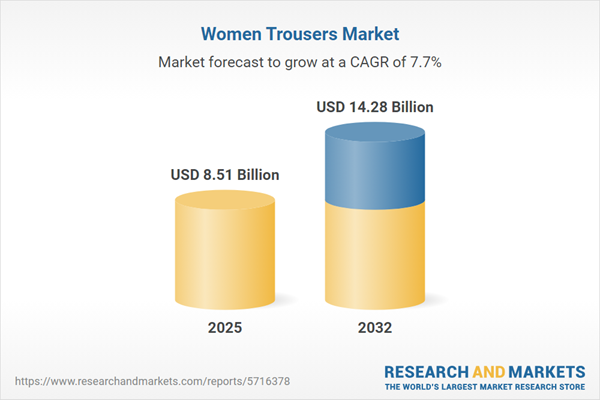Speak directly to the analyst to clarify any post sales queries you may have.
Senior decision-makers in the women’s trousers market face a dynamic environment shaped by evolving consumer preferences, rising adoption of digital retail, and heightened demand for fast adaptation. In this landscape, agility and data-driven decision-making are essential for sustained relevance and competitive growth.
Market Snapshot: Global Women’s Trousers Market Overview
The global women’s trousers market is moving forward at a steady pace, valued at USD 7.91 billion in 2024 and anticipated to reach USD 14.28 billion by 2032, with a CAGR of 7.66%. Key drivers include the expansion of digital sales platforms, advances in logistics infrastructure, and the influence of international fashion trends. Leading companies are prioritizing premium product offerings while investing in seamless omnichannel strategies, leveraging digital technologies to better engage their customer base and foster brand loyalty. Across the sector, organizational focus remains on a digital-first model and operational flexibility to ensure sustainable advantage amid ongoing market shifts.
Scope & Segmentation in the Women’s Trousers Market
Effective segmentation underpins precise resource allocation and strategic planning in the women’s trousers market, enabling organizations to anticipate consumer demand and pivot regionally as needed. Core segments provide a practical framework for data-driven action:
- Distribution Channels: Department stores, hypermarkets, supermarkets, specialty retail outlets, top e-retailers, and branded digital platforms each cater to specific buying behaviours, extending reach to varied consumer segments.
- Fabric Types: Cotton, denim, polyester, and a spectrum of additional fabrics address diverse international demands for comfort, resilience, and visual differentiation.
- Fits: Bootcut, skinny, slim, straight, and wide-leg designs enable brands to adjust collections, aligning with rapid shifts in style trends across regions.
- Price Ranges: Value, mid-tier, and premium pricing tiers help brands target multiple income groups, supporting tailored marketing and product portfolio strategies.
- Rise Options: Low, mid, and high-rise options accommodate global variations in ergonomic needs and style preferences.
- End Uses: Solutions for casual, formal, and sports-oriented (including gym and yoga) purposes respond to the growing demand for functional versatility in wardrobes.
- Closure Types: Button and zipper closures remain important differentiators, enhancing convenience and product identity in new launches.
- Lengths: Capri, full-length, and shorts provide adaptability, aligning with regional climates, seasonality, and activity-driven preferences.
- Regions: Americas, Europe, Middle East & Africa, and Asia-Pacific are critical for tailored approaches due to their unique demographics, regulations, and cultural dynamics.
- Key Companies: Leading players such as Nike, INDUSTRIA DE DISEÑO TEXTIL, adidas, H & M, Fast Retailing, Kering, VF Corporation, Gap, PVH Corp., and Lululemon Athletica set industry pace in product innovation and scaling operations.
Recognizing and acting on these segmentation criteria allows organizations to plan granular investments, develop adaptive regional strategies, and proactively align with consumer and supply chain developments.
Key Takeaways for Senior Decision-Makers
- Pursuing transparent sourcing and responsible manufacturing practices can strengthen trust and brand perception amid intensifying competition.
- Strong omnichannel retail experiences are crucial for creating deeper consumer engagement and promoting ongoing loyalty throughout the customer journey.
- Incorporating advanced solutions like virtual fittings and functional textiles can optimize inventory processes and reduce product return rates.
- Expanding selections by style, fit, and price range enables swift response to evolving consumer preferences and deeper segment penetration.
- Regionalized logistics and increased operational transparency equip organizations to navigate local complexities and reinforce business resilience.
Impact of Tariff Changes: Strategic and Cost Implications
Recent tariff adjustments in the United States are prompting organizations within the women’s trousers market to reevaluate sourcing and cost control strategies. Executive teams are renegotiating supplier contracts, diversifying supplier bases, increasing investments in automation, and reviewing manufacturing footprints. This shift underscores the importance of heightened supply chain visibility and agility, allowing firms to maintain cost stability and advance robust long-term planning amid unpredictable global conditions.
Methodology & Data Sources
Findings in this report are based on executive interviews, industry expert input from supply chain and retail specialists, and validated secondary research. Scenario planning and benchmarking practices ensure the insights are relevant, pragmatic, and directly aligned with leadership priorities.
Why This Report Matters for Senior Leadership
- Delivers actionable benchmarks and comprehensive analysis to support data-driven decisions for entry, expansion, or repositioning in key market segments.
- Prepares leadership to spearhead digital transformation and fortify supply chain resilience in the face of sector evolution and uncertainty.
- Enables confident decision-making with reliable, industry-tested data for smarter risk reduction and long-term value growth.
Conclusion & Strategic Outlook
Leveraging robust segmentation, embracing digital innovation, and maintaining flexible operations empowers organizations to navigate transformative shifts and safeguard continued success in the global women’s trousers market.
Additional Product Information:
- Purchase of this report includes 1 year online access with quarterly updates.
- This report can be updated on request. Please contact our Customer Experience team using the Ask a Question widget on our website.
Table of Contents
3. Executive Summary
4. Market Overview
7. Cumulative Impact of Artificial Intelligence 2025
Companies Mentioned
The companies profiled in this Women's Trousers market report include:- Nike, Inc.
- INDUSTRIA DE DISEÑO TEXTIL, S.A.
- adidas AG
- H & M Hennes & Mauritz AB
- Fast Retailing Co., Ltd.
- Kering S.A.
- VF Corporation
- Gap Inc.
- PVH Corp.
- Lululemon Athletica Inc.
Table Information
| Report Attribute | Details |
|---|---|
| No. of Pages | 181 |
| Published | October 2025 |
| Forecast Period | 2025 - 2032 |
| Estimated Market Value ( USD | $ 8.51 Billion |
| Forecasted Market Value ( USD | $ 14.28 Billion |
| Compound Annual Growth Rate | 7.6% |
| Regions Covered | Global |
| No. of Companies Mentioned | 11 |









